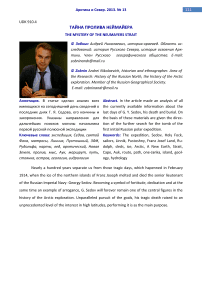The mystery of the Neumayers strait
Автор: Zobnin A.N.
Журнал: Arctic and North @arctic-and-north
Рубрика: Historical sciences
Статья в выпуске: 13, 2013 года.
Бесплатный доступ
In the article made an analysis of all the currently available information about the last days of G. Y. Sedov, his death and burial. On the basis of these materials are given the direction of the further search for the tomb of the first initial Russian polar expedition.
The expedition, Sedov, Holy Fock, sailors, Linnik, Pustoshny, Franz Josef Land, Rudolph, sleds, ice, Arctic, A New Earth, Strait, Cape, Auk, route, path, one-Janka, island, geology, hydrology
Короткий адрес: https://sciup.org/148319893
IDR: 148319893 | УДК: 910.4
Текст научной статьи The mystery of the Neumayers strait
Nearly a hundred years separate us from those tragic days, which hapenned in February 1914, when the ice of the northern islands of Franz Joseph melted and died the senior lieutenant of the Russian Imperial Navy- Georgy Sedov. Becoming a symbol of fortitude, dedication and at the same time an example of arrogance, G. Sedov will forever remain one of the central figures in the history of the Arctic exploration. Unparalleled pursuit of the goals, his tragic death raised to an unprecedented level of the interest in high latitudes, performing it is as the main purpose.
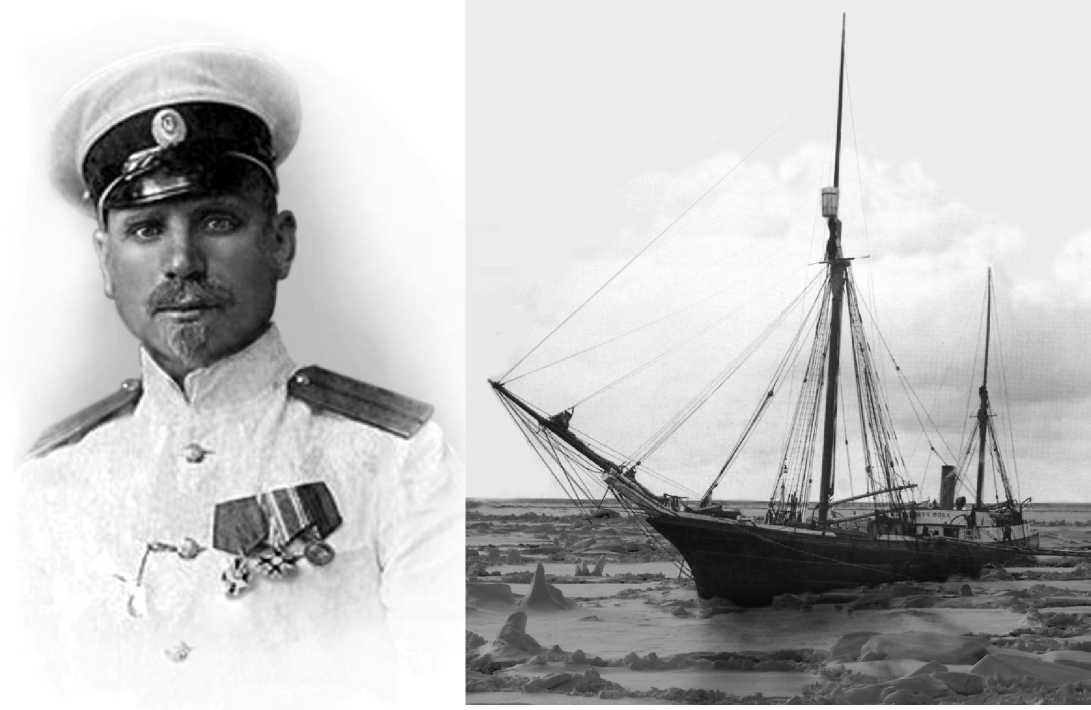
Many publications, especially recently, accusing Georgy Sedov in extremely poor organization of the expedition, inspired more time. We must not forget about the three expeditions, published in the Arctic summer of 1912 and from the expedition returned only G. Sedov. Rusanov -Accusing Chief of the pole expedition unprepared the project and went on the completely unnecessary risk, knowingly about the condemning people, who confided to him the trials and the tragic death of the whole expedition, whereas G. Sedov sacrificed their aspirations only themselves. As for the mechanics of the vessel Zander, who was crushed of the scurvy island of Hooker, the little expedition which avoided the deaths after two Arctic winters.
In 1915 L. Breytfus wrote: "... recognizing our brave researchers, rare fanatical energy, in spite of all obstacles, walked forward to the goal, we wish and hope that that the explosion of interest in the wide north circles of the society, which caused particularly Sedovs expedition, has not gone without a trace, and that in the future a broad and systematic study of the Arctic region was supported by public sympathy "[1].
Few of the pioneers won such fame and glory as G.Y. Sedov. And, apparently, the last 100 years, all that could be associated with the first Russian polar expedition. But the circumstances of the death and burial of its chief still cause a lot of controversy, conjecture. Reason for this was long, but, unfortunately, unsuccessful search of the graves of Sedov.
In the summer of 1937 on the coastal slope near Cape Auk, winterers H. Libin were found items that, according to the testimony of the sailors Linnik and Barren, had to be in the grave: flag pole with copper sleeve, which remained about the engraved "Expedition of Sedov. 1912-1914". "Rusty hatchet, torn of the Russian national flag, fragments of fur garments, pieces of the rope and canvas fabrics. Sledges, remains under a stone on the embankment disappeared".
Starting with high-latitude of the expedition of O. Schmidt on the icebreaker "G. Sedov" in the summer of 1929 and to prospecting the crew of the yacht "Apostol Andrey", club "Adventure" in 2011, searching for the traces of the burial takes a lot of the generations of the explorers in the Arctic. The question posed in 1914 by the crew of "St. Phocas"- "Where is the grave of G. Sedov?" By 100 years remains unanswered.
The reasons for this are logically to note two: stone mound with the remains had been destroyed or it was never there. These were the main conclusion and direction of the present investigation, the purpose of which is not to make a final decision, but on the basis of the facts and documents to consider all possible versions, which could be as close to understanding what really happened on the ice Neumayer Strait in February 1914.
The first step is to trace the path of the expedition on. Jackson and before the approach of the sailors to the Frozen Cape, because these days it is necessary to consider the whole tragic finale pole expedition. Information diaries of Sedov, Linnik and Pustoshny allow making the parallel way on a modern map and the map of G. Sedov. Such a comparison will provide an opportunity to see the features of the route of the expedition, which were poorly represented in previous studies.
Small problem here was to find a card that could be at G. Sedov during the polar expedition. By reviewing several options, including drawings of Nansen, who helped to co-driver "St. Anna". V. Albanova reach the Cape Flora, it was natural to focus on a more complete ones - Expedition Map Duke of Abruzzi (Principe Luigi Amedeo di Savoia, Duca degli Abruzzi) [2] on the barge of"Stella Polare" (1899-1900) (Fig.1). At the first comparing it with diary notes of G. Sedov no longer any doubt that he enjoyed a similar card, only in English. Drafted materials of the expeditions of Payer (1872-1874), Lee Smith (1880-1881), Jackson (1994-1997), Nansen (1895-1896), in 1912 it was the most reliable map of PFI. As will be seen further guidance it exactly coincided with the specified route of the expedition.
On Monday, February 10, the pole of G. Sedovs expedition came to Cape Island Klimentsa Jackson. From this point begins the confusion straits and islands. Reading the existing map of Sedov no doubt that on the other side of the bay is visible DeLong Land Charles Alexander. In fact, it was the north-eastern part of the island Jackson (Figs. 1 and 2).
The next evening, taking in the Cape Helland Breggera, he wrote in his diary: "... In 4 hours stood for the night, going about 15 miles to the Earth Alexander. Today it seemed almost sun. Already seen Teplitz-bay. I feel better, because i warmly dressed and had sat quietly on the sled" [3]. In fact, he did not see the bay Teplitz of the Rudolf Island and the western shore of the island of Alexander, to shape the coastline really like Teplitz-bay.
The next day, 12 February, a group crossed the Strait of Baka and only now came to the island of Charles Alexander. The map of Sedov showed otherwise. "Gone ... about 15 miles - wrote George, - and stopped at 4 hours for the sleeping at the Earth Rudolf. Today was a minimum -42 °. Now blowing points on 4 Ost. Tent considerably ruffled, we're like gypsies, sit around a kerosene stove" [3].
February 13 at 9 am the expedition moved to the west coast of the island of Alexander and five miles came to a small island off Cape Breggera Islands (Pontremoli). In the belief that they are on the south-western coast of the island of Rudolph, "the whole day Pustoshny wrote and searched Teplitz-bay." Sedov was also at a loss: "... Wandered into some strait between the islands, but not in Teplitz-bye, though he already felt close. After 2 appeared the sun became a wonderful, warm day, but the road is heavy: the snow and ropac. In the ocean, you can see a lot of water, as seen with the black sky. In 5 hours stopped for the night, it seems the Earth Rudolf difficult to judge with confidence, as in this terrible place card is not valid. Let's see what will be tomorrow ..." [3].
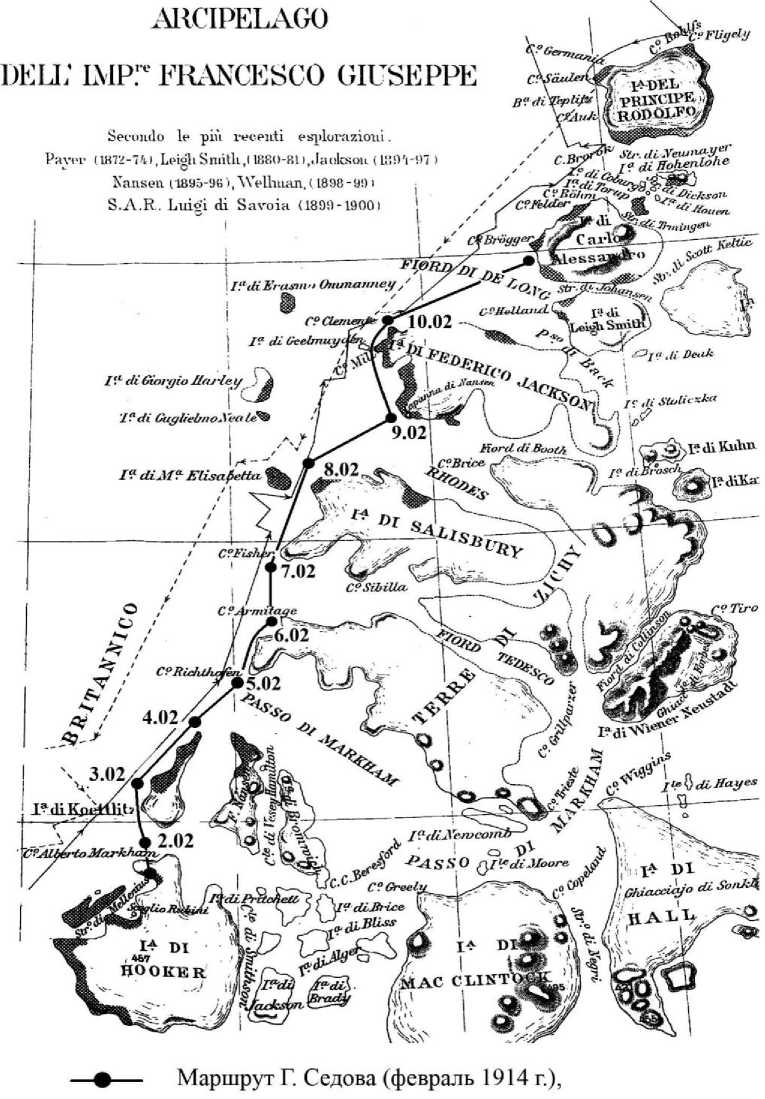
Pic. 1. The map of the expedition of Duke A. Abruzkogo
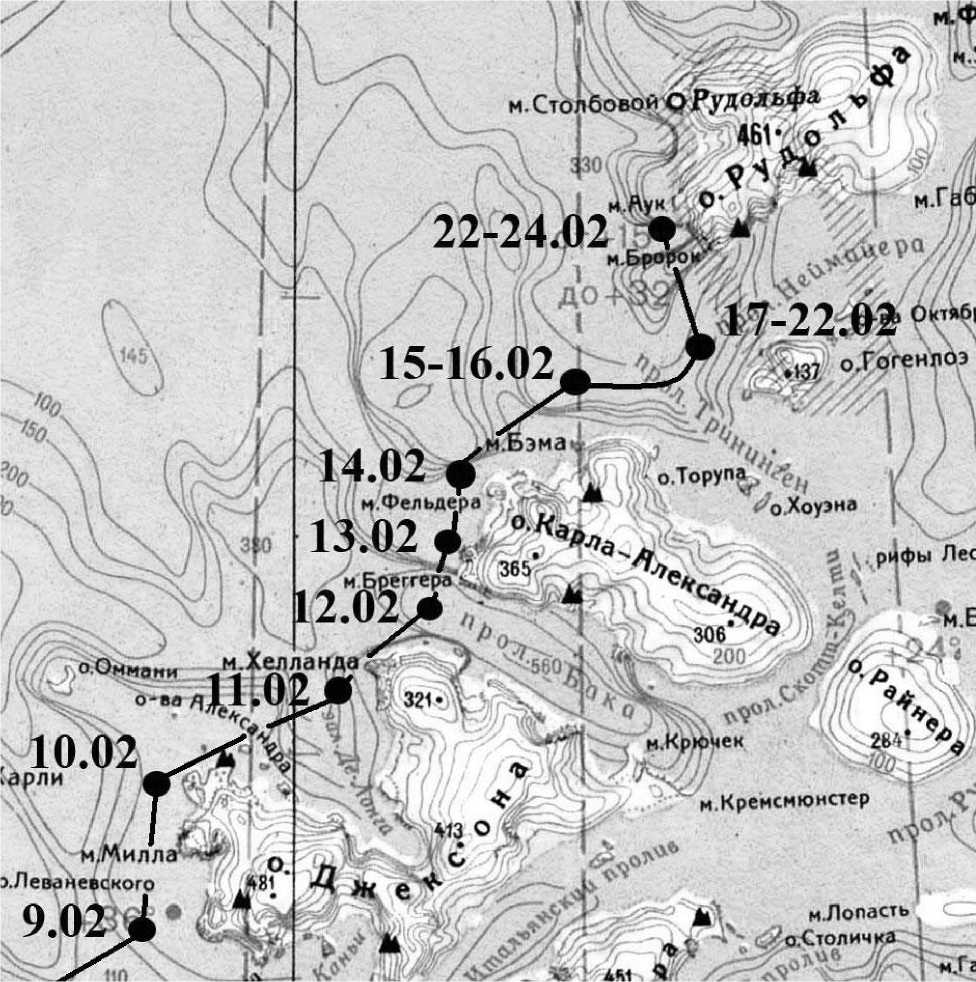
Pic 2. The modern map of the Northern Islands of ZFI
February 14, at three in the afternoon, the expedition left to the north-western tip of the island of Alexander, to the islands of Cape Chichagov. Only here Georgy Yakovlevich realized where they are. "Snow, fog, - he wrote - nothing to see, dogs are not driven. Trudged about 3-4 miles and camped. A group of small islands between the Earth and Rudolf Alexander (most of S. N), to the W and N water, nothing can be seen" [3]. In this record, it is important to pay attention to the notes in the brackets, which could designate only "in the most northern cape" ("S." - it is nothing like the English "care" - cape). This is quite definitely confirms the group of Feb. 14 at the north-western tip of the Earth Alexander. This point is very important for understanding their future path.
The next morning Pustoshny climbed onto one of the islands and at the north-east saw the Earth. Without a doubt, it was Rudolf Island. Of the three diaries shows that to the north and west were open waters.
At 9 am, the group moved as Pustoshny wrote, "from the coast towards the ground where lay our way." That is, we must understand right in the Strait to the island Triningen Rudolph. It also confirms the entry of Sedov, "Saturday, February 15. At 10 is clear frost of 30 degrees. Went through the straits to the Earth Rudolf, which was clearly visible, going about 12 miles away, stumbled upon a continuous, thin (1 ver.) Etosha" [3]. About the distance covered in the diaries, there are significant differences that are difficult to explain a simple slip of the pen. Pustoshny noted "11/2 mile" while Linnik quite clearly indicated that "passed no more than one mile, seen from all sides ahead quite fresh ice". I guess it would be logical to trust the two, almost identical readings of Sedov and determine that on February 15, the camp was approximately in 7 miles to the north of Cape Bam (Fig. 3).
Sunday February 16 Mardi Gras. Pustoshny wrote in his diary: "Today, far from their homeland under 82° the north latitude on 4 inch saltmarsh we celebrated the Carnival and remembered each as walk our comrades, and we sit by the sea and wait for a good frost to brace saline to move us to the north" [4]. Sedov looked at the meal of the sailors, among other things, wrote: "... of course, would eat the egg, sour cream, fried chicken, even a cup of sauerkraut. But where was all this? ... "As a holiday gift the sun came out" We saw the mountains above the first sweet, dear sun - happy Georgy Yakovlevich. - Oh, how beautiful it was and well! At the sight of it, our world upsided down. Greetings to you, a wonderful miracle of nature! Shine of our loved ones at home, we stayed in a tent, as sick, dejected, at 82 ° north latitude" [3].
After a celebratory lunch of the sailors went to inspect the road. Coming to the east about seven miles away, they realized that "it was impossible to go straight, and you needed to go east, and then be forwarded to our land". Fear that the gale will break the thin ice on which stood the camp, it was decided to continue the path to the island Rudolph took to Ost.
February 17th, in the evening, the travelers were at the southern tip of the island, close to the shore fast ice. Strong storm for three days stoped the advance. State of health deteriorated rapidly the head of the expedition, and he could not write. The last lines in his diary: "Monday, February 17". Three days later, February 20, 1914, in 2 hours and 40 minutes of the day G. Y. Sedov died.
Guide further actions took the sailor G. Linnik. "In Teplitz Bae or elsewhere on the island -he wrote - leave half the cost, and if we do not find kerosene, we had to bury boss. Tomorrow I think to go further. And if it would be wintering Abruzzi, it will be passable, and if not, the body will have to leave of the chief". Besides, there were the signs of scurvy barren. Here it should be noted that the confidence that they are on the island and the bay Rudolf Teplitz-bye very close, they were not enough. The recent confusion with the islands and straits significantly undermined their confidence in the map.
Two days after the death of the chief, February 22, the sailors headed along the west coast of the island. "At three o'clock in the afternoon - wrote Linnik - barely dragged themselves to the Ice Cape and 300 fathoms, or 400 from the shore camped since, firstly, old ice ends and begins a completely fresh saline, and secondly, dogs driven nothing" [5].
Only Cape on their way, which can be called the Ice, was without a doubt, the glacier front of Cape Auk (Fig. 3). For a more complete confirmation that the sailors went to Cape Auk is necessary to pay attention to all the details mentioned in the diaries, and consider some scenarios, from February 15. On this day Pustoshny first saw Rudolf Island (land to the north-east), it would be natural in this case to sail to the south-west, ie the Cape Felder. At this point nothing but Rudolf Island was not visible. And the next day already traverse Cape Bam take any other island, for example, Hohenlohe, for the island of Rudolph, especially for a whole, is quite impossible. Neumayer strait is clearly visible here. The likelihood of such errors could be, if you look at these islands from the south-eastern part of the Earth Alexander. But doubt that Sedov went around the island from the west, there is no information.
In addition, further their way precisely specified in the records of Linnik. February 17, among other things, he noted that "fortunately, the road is very good and we were moving forward rapidly. But before they reached the island a couple of miles of Crown Prince Rudolf, I like walking in front, began to roll with fresh ice on the old, heading to the island, and at the junction of fresh ice with the old ..." [5]. Here you can see what else February 17 expedition was three miles from the island at the junction of Rudolf fresh ice Strait Neumayer and fast ice island.
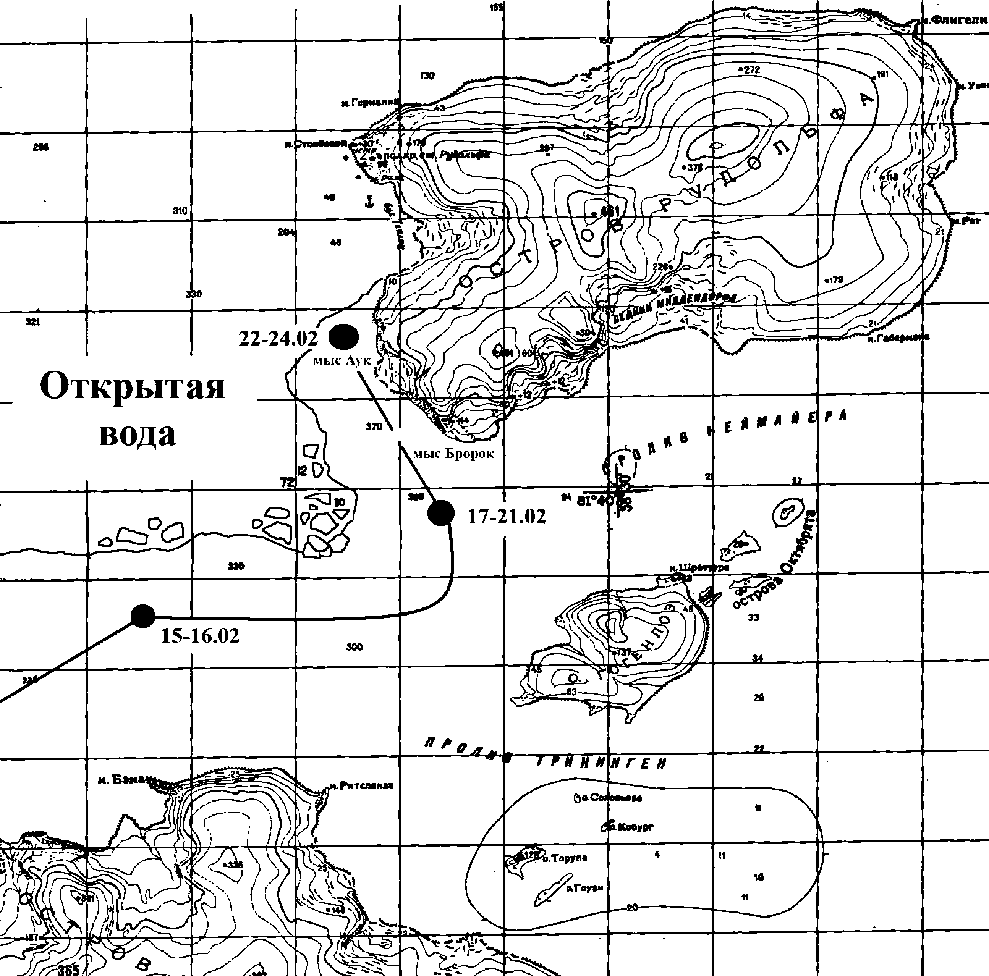
Pic. 3. The Island of Rudolf
In addition, further their way precisely specified in the records of Linnik. February 17, among other things, he noted that "fortunately, the road is very good and we were moving forward rapidly. But before they reached the island a couple of miles of Crown Prince Rudolf, I like walking straighr, began to roll with fresh ice on the old, heading to the island, and at the junction of fresh ice with the old ... " [5]. Here you can see what else on the February 17, the expedition was three miles from the island at the junction of Rudolf fresh ice Strait Neumayer and fast ice island. And if so, then a six-hour shift with the body of the head of the expedition on February 22 could be only along the west coast of the island of Rudolph, ie to Cape Auk (Fig. 3). Pustoshny accurately points out: "We moved slowly and walked 7 miles from the parking, we again pitched a tent on the old glacial ice of 300 yards from the high bank, which shows a lot of stones. When we pitched a tent, then went further to the north, watch the road and place that cape, to which we were going and, in our opinion, and he also Teplitz-bay ".
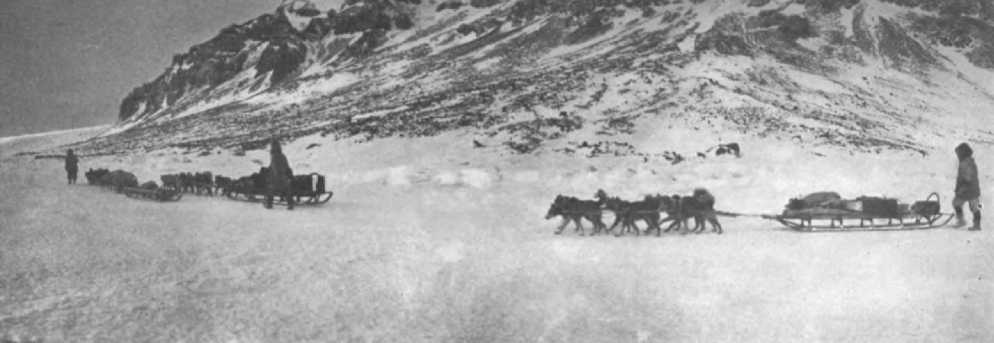
Pic. 4. The cape Auk
From Cape Brorok sailors could not see the bay of Teplitz. First it said HSU, Academician E. K. Fedorov. In his "Polar diaries" he recalled, "According to the description of the sailors, it was believed that the tomb is located at the foot of the Sedov Cape Brorok. I carefully examined every square meter of the shore, but the graves were not found. I did not know then that he was a few kilometers to the north - under a cliff Cape Auk. In the summer of 1937, the polar station on Rudolf Island found there a staff with a scrap of Russian flag and a few things, of course, owned by Georgy Sedov. Linnik and Pustoshnys little mistake in the description of the place. It was understandable. And I could understand that only from Cape Auk, but not from Broroka, overlooks the bay of Teplitz, only here Linnik and Pustoshny could not see the ice in the bay" [6].
In fact, the sailors were not wrong in their diaries rather accurately describe the path to the end point of the travel and, even more surprisingly, gave a detailed description of the place where he buried the head of the expedition. With their words expedition artist N. Pinegin made a drawing (Fig. 4).
In the summer of 2011 the crew of the yacht "Apostol Andrey" club "Adventure" with Captain N. Litau approached the west coast of the island of Rudolph to compare the figure with the real N. Pinegins overlooking of Cape Auk. "The boat moved to the edge of the rare ice - wrote in his diary, Captain - and from the point where you opened the whole coast from Cape Auk Stolbovoye, it became apparent how this picture looks like a picture archive. They certainly do not coincide completely. So, at Cape Auk was not so deep as in the picture, and Cape Stolbovoy had not two peaks, but flat and not pointed, as depicted by the artist. This was perhaps the main difference. Otherwise, everything was in place: Right - sheer cape Auk, left - headed Stolbovoy between them water" [7].
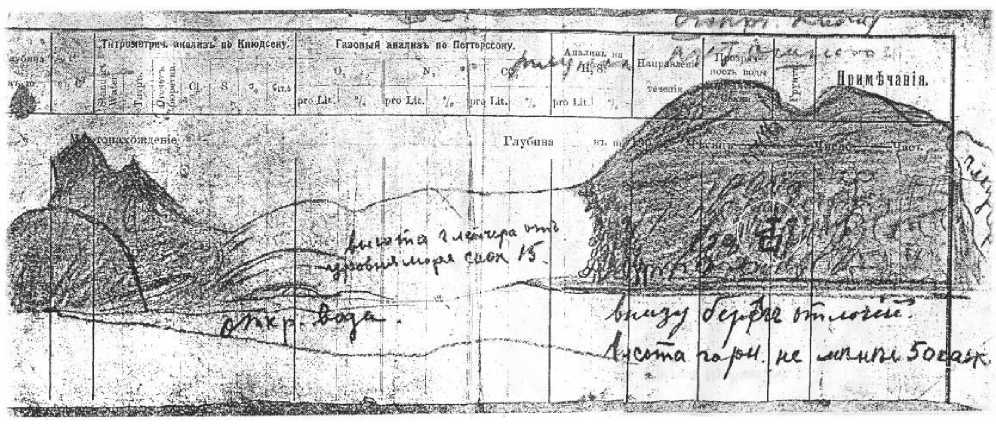
Pic. 5. The picture by N. Pinegin. Burial place of G.Sedov
Thus, it must be considered proven that the last parking spot and sailors Linnik was barren Cape Auk. On this basis, according to the sailors, it would be natural to assume that the tomb of G. Sedov is under a cliff this cape, "on the slope height up to six yards from the sea level", as shown in the figure of Pinegin. But it is not there, except for a few items, including a flag pole with brass sleeve, which remained engraved "Expedition leit. Sedov's 1912-1914". Its belonging no doubt.
***
The most common assumption among historians about the causes of the disappearance of the glacier became the grave of Sedov, who could carry on the sea stone hill with his remains, leaving the surface of the items. This version is more likely could clarify the situation, if not objections of other specialists - glaciologists. Rudolf Island is 98% covered by a glacier. In the central part of the ice cap surface is relatively flat, but the periphery is becoming greater bias and goes into the origins of the valley glaciers that break off into the sea, forming icebergs. We are interested in the western part of Rudolph, according to the experts, have a more complicated dissected relief than the east, and are "elongated depression in the bedrock relief of the island, which in most cases are a continuation of bays". This is the so-called outlet glaciers, which account for a growing mass of ice is given in the sea. Outlet glaciers, located on the both sides of Cape Auk Rudolf Island, a short, but with a broad front in the output. Glaciologists say that the probability of slipping from the top of Glacier Point Auk is so small that it can hardly be considered necessary. This could only take place in case of the increase in the central part of the ice, and this is a global glaciation.
It should also be noted that avalanches than slipping glacier bring such devastation could not because of the small height of the cape. This is confirmed by the memorials established at different times on the Cape and Cape Brorok Auk. Signs stood there much longer alleged burial Sedov, but did not disappear without a trace. This refutes the argument over other versions of the natural causes of the destruction.
In addition, it was possible to draw attention to the possibility of destroying graves by the polar bear. There is ample evidence that these animals are easily moved a large stones. This version is simple and has the largest number of thevsupporters. One could take it as a basis and to put an end, if not for the circumstances that make the most cautious approach to the analysis of the materials of this complex.
* * *
Immediately upon arrival, "St. Martyr. Foca" ("Michael Suvorina") in Arkhangelsk, the Committee Gear expedition to the North Pole and Russian polar research countries immediately filed a petition for an investigation of the causes of the death of Lieutenant G. Sedov" in order just to remove all responsibility and possible criticism.
Committee Secretary Captain of the2nd rank P. I. Belavenets in his testimony Petrograd Prosecutor on December 5, 1914 wrote: "I personally, as well as in other members of the Committee, after reading the first news about the death of Lieutenant George Sedov, had a natural suspicion of his death. Upon arrival in Petrograd Sedov expeditions members that suspicion is not dissipated, and after talking with arrived in Petrograd veterinarian Kushakova party the same expedition, this suspicion was reinforced. Kushakov being closest collaborator to Sedov and the only one in my opinion, "respectable man" of all who served on the ship, in a conversation with me, he told me a number of abnormal phenomena in the life of the ship's crew: especially noticed Kushakov the increased demands from the sailors and Linnik Pustoshny, who several times was satisfied with Sedov, apparently referring only to an urgent need for the participation of these sailors in the transitions to the North Pole. Reach the pole of Sedov was a dream, and he is in no matter what was decided to implement it, despite certainly set their painful condition before leaving. Knowing this "idéefixe"Sedov, sailors who were to accompany him to the pole, exploited Sedov, when he refused them meet their excessive demands, threatened him with "crack down" the road to the North Pole "[8].
Here P. Belavenets pointed out that the documents of the expedition, including diaries of Sedov, book orders and the logbook were with him, but evidence of the relationship to the head of the expedition sailors, that is orders of the punishment Linnik, were not detected. Last blog of
Sedov (February 1914) was sent to the prosecutor of Arkhangelsk Regional Court, and all other blogs transferred to the widow of Sedov - Vera Valerianovna, who lived at that time in Petrograd.
Thus, the Committee Gear expedition to the North Pole and Russian polar research countries, guided by the testimony of P. Kushakova and their own reasons, was inclined to believe that a crime might have occurred.
Of course, the natural suspicion of the death of Sedov emerged largely from the words of Kushakov, who has repeatedly expressed his displeasure with the behavior of the sailors.
Here is one of his reports filed chief of the expedition shortly before the release of the pole groups: "Hs number while on duty, I heard a loud noise and screaming into the dining room command. Coming to the last, I heard the voice of the sailor Linnik, swear oaths and obscenities, shouting: "I'm going to the North Pole, risking my life, but because I will not eat any rubbish". …Despite the secondary ... commanded silence, sailor Linnik in the presence of the whole team, more and more, raising his voice began to put me insulting words, accusing that I am the evil of the expedition, not interfere in the business, all cheating, etc. Finding a real act ... sailor Linnik, as well as several other of his actions, with a tendency to disturb the whole team, constant censure and cussing at all persons in authority of the expedition, not excluding you, as well as a complete unwillingness to obey not only the basic requirements of the law, but also demands of your orders, — highly non-disciplinary, ruining business expedition associated with the dignity of the whole country, honor Russian name and Russian flag - I ask you about the tradition sailor Linnik court. Duty Officer of P. Kushakov".
* * *
September 12, 1914 Assistant Prosecutor Arkhangelsk district court questioned Taratin sailors Linnik and barren. Their testimony differed little from the diary.
From the interview of Mr. Linnik, 26 years old, was from Poltava province, Orthodox educated "... On February 20, in the afternoon Sedov had asked and I cooked him broth, but Sedov had not eat it, as with Sedov had a fit - began to complain that the torn chest that he could not get warm, despite all the measures we are taking, lost consciousness, went out of his mouth foam. I’m beside him, supporting his head. Sedovs last words were: "My God, Linnik, supported". Sedov died and when 15 minutes later, holding his head, I looked him in the face, I found that Sedov dead. It was 2 hours and 40 minutes on February 20 this year. With great difficulty, we got to the land located near barren and buried Sedov, making a cross of two stashed skis. We could not dig a grave, and besieged the frozen corpse of the stones, putting on the right side of the corpse flag. Graves location on the southwestern side of the island 12 miles of Crown Prince Rudolf of the wintering
Duke of Abruzzi, in 5 fathoms of the sea level on the shore under a rock. Since we removed the corpse only pocket chronometer, all the same clothes he was wearing, not touched.
The indications of A. M. Pustoshnii, "23 years old, peasant of the village of the Arkhangelsk province" just not brought anything new. "We buried him on the southern tip of the island of Crown Prince Rudolf - he recalled the last day of Rudolf Island - 12-15 miles from wintering grounds on the banks of the Duke of Abruzzi on the slope in 20 fathoms of water and 5 yards from the sea level, and the grave put a flag on a pole with an inscription in English: "Sedov expedition, 1912" [9].
It is clear that in the absence of the evidence to the prosecutor of the Arkhangelsk Regional Court had no choice as to close the case for lack of the evidence. Nobody could not assume that ther was not the grave on the island Rudolph. This fact no doubt would be an important fact in the investigation of the causes of the death Sedov.
In the summer of 1929, the crew of the icebreaker "G. Sedov" tried in vain to look for the grave at Cape Brorok. But even then, no one had any doubt about the veracity of testimony and barren Linnik. All explained by the natural causes. "Ice streams rushing with glacier meltwater scouring boulders, causing a heap of sand and clay - wrote one of the participants - apparently not spared and the last resting of Georgy Sedov[10]. Participants, searches set up on a red board with the inscription in Russian and English languages "Soviet expedition of the icebreaker Sedov" in 1929.
The question arises, why in 1937, before the discovery of the items belonging to Sedov, was regarded as the burial place of the Cape Brorok? The answer to it could become protocols inquiry of B. Wiese. Back in March 1914 upon arrival at the ship sailors told everything that happened to them, and as the evidence submitted their diaries and diary of G. Sedov. Acting head of the expedition P. Kushakov instructed geographer B. Wiese carry out some kind inquiry. After some questioning and reading diaries from the governing of the expedition prevalent opinion that the tomb is located at Cape Brorok.
After the captain of the 2 rank- P. Belavenets Petrograd prosecutor wrote: "The Protocols of the survey are from Wiese, that does not deny himself, but my suggestion to transfer these readings Committee, said only" good, good ", but these documents were not passed" [8].
Even without this protocol is not difficult to understand that everything is based on oral testimony of the sailors, who pointed to the Cape Brorok. Later N. Pinegin wondering "Where was Sedov grave?" Wrote: "Linnik and Pustoshny not read the card with them incomprehensible English inscriptions. From the words of returnees can be assumed: at Cape Brorok Earth Rudolf, at the foot of the steep bank, at the height of ten meters from the sea, in the place where it ends the eastern part of the glacier and starts the rocky shore" [11].
It traced the apparent discrepancies, which attributed to simple ignorance of the sailors. After all, no one even noticed how different information of the sailors diaries with their stories on arrival at the ship. The first thing that catches your eye - why sailors have focused precisely on Cape Brorok as the end point of its travel? Even with the known magnetic anomalies in the Strait of Neumayer, we must try hard not to recognize the extended south cape, just marked on the map (Fig. 5). Besides the sailors did not have to "read" the map as Pinegin believed, and still many researchers believe that they could simply collate seen with a card that would not be a big deal. Their diaries say enough for this education. Biggest mistake would be to explain everything to illiteracy sailors. In their diaries, they wrote and read the testimony, exactly as the inscription engraved on the flag pole, "Expedition of Sedov 1912-1914". And thus can not distinguish "Auk" on "Brorok", that at least surprising.
Little faith and that sailor Linnik could map their stops at the island with Rudolf and safely, just ten days, came back to the ship.
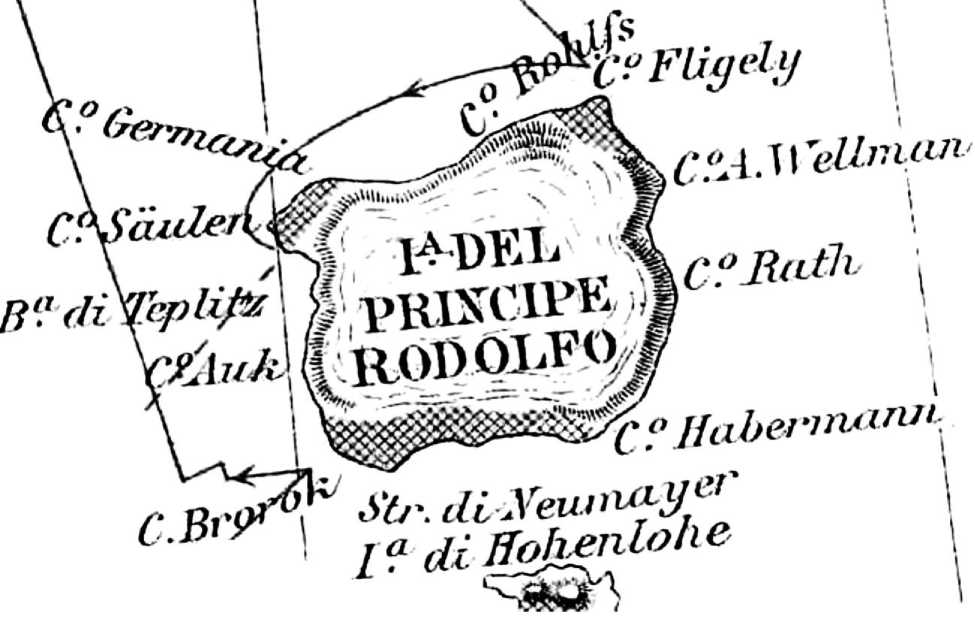
Pic. 6. The cape Brorok
She told Popov a chilling story, according to which the sailors Linnik and Pustoshny on arrival in Arkhangelsk confessed to his father that after the death of their chief, they dismembered his body and scattered around the island, thus the grave was destroyed by the polar bear. Xenia’s fa- ther, Peter Mineyko, at the time of the Arkhangelsk port engineer, was friendly with Sedov and took some part in the preparing for the expedition. Apparently, sailors knew and trusted engineer, otherwise this sensational information inevitably would fall into the investigation materials.
This development is more like a low-budget thriller script, could be considered even if this information came from people outsiders. In the same decency K. Popov is no doubt, therefore, making a difficult choice between being able to accept them as a fact witness, and the prosecution of their lies, preference is undoubtedly the first. On the surface, one might think that the motive for such an act can only be an attempt to cover up the crime, ie murder Sedov. But for some analysis you can find this and other explanation. The fact that the diaries of the sailors and their statements give a complete picture of the death of their leader, and with many details that it would be impossible to come up in the difficult conditions of the writing diaries. Anyway, no one line is not in doubt in naturally occurring. To commit such a crime and concealment of his skilful and daring needed extreme cynicism. Such traits could not be seen for two wintering, where each person is revealed according to their inclinations. Linnik, most doubtful their discontent action of officers, was generally characterized by the expedition of B. Wiese and N. Pinegin. Therefore, by exceeding the arguments for the absence, as a fact of the natural death of Sedov to prove the converse is quite impossible.
In this case, the main reason for the lack of the graves is likely to be found in the actions of the sailors after the death of Sedov. Initially, February 20, they are "mutually" decided to maintain the body to the vessel ". The body of his boss - wrote Linnik on February 21 - struggled trying to deliver the ship, as it was expensive to us all the same". But by the evening of the same day the solution to their changing: "... if we do not have kerosene, you have to bury boss". What has caused such a change?
Of course, one would assume that a day later, when gradually subsided experiences sailors have to soberly assess their situation and realized that the lack of fuel in the event of unforeseen circumstances on the way back to face death, and therefore decided to burial. But if the whole issue was a lack of kerosene, as explained sailors, why they did not even try to take him on the basis of the Abruzzi? After swim in one bay empty kayak would be a matter of a few hours. There is something to think about.
Interesting in this regard may be one episode that occurred at the station Rudolf Island. Known polar navigator B. Akkuratov recalled how in 1937-1938. Pilot I. Mazuruk after landing at the North Pole were left to drift insurance SP-1 and explored the ruins of the Italian and American expeditions Abruzzi and Fiala. "One day - remember Valentin - we got a strange and unexpected find. Clearing the ice one of the rooms of a residential house of the American expedition, on the table beside the bunk we found ... ladies' shoes! Lacquered, small size, a little worn and perfectly preserved. On the inner side, on white kid lining stood golden stamp with the inscription: "Supplier of the Court of his Imperial Majesty. St. Petersburg". One thing was clear: in expedition of Sedov women did not participate. So, this shoe was a souvenir ... But whose? Apparently, Georgy Sedov, who married before the march to the famous ballerina May-Majewski. It’s something he took the shoe, probably with them as a memory of his wife. Scrupulously as the most meticulous archaeologists and detectives, we continued the search. But, alas, no other findings are not followed ... "[12].
Given the fact that in Teplitz Bay until 1936 came only one Russian expedition on the icebreaker "Sedov" (1929) and spent the winter on the polar station of F. I. Balabina (1932-1933). We would assume that the shoe bought in Arkhangelsk and brought here by one of the Italian or American expeditions 1899-1905. But, according to the pilots, the shoe was slightly that largely refutes this version. Packing starched collar and silk shirts, O. Schmidt expedition discovered in 1929 on the basis of Teplitz Bay, do not cause particular surprise. But ladies' shoes, the more Russian-made, could hardly belong to the foreigners.
Expected visit Teplitz Bay of the crew of "St. Anna" has even less likely here. Akkuratova assumption of the accessories shoes of Sedov, he could take in order to leave a symbolic mark on the North Pole, also finds no documentary evidence. The only credible witnesses here can be Linnik, Pustoshny and wife Vera Valeryanovna Sedova. Who does not like, they knew the secret intentions of Sedov.
Skipper Akkuratov in his time could solve this issue very easily. He needed only to meet with Vera Valeryanovna who lived in Leningrad, and to tell her about his discovery. And if the description she identified her shoe, then this evidence would be so loud that undoubtedly led to a revision of all the events pole campaign, and sailors in the 30-ies. The last century have been convicted of lying and likely charged with a crime. But this did not happen. Pilots in the heat of the cases of the national importance appear to have forgotten about the discovery in the Bay of Teplitz and slipper for many years remained. In addition, at Cape Auk were soon found fragments of things of Sedov.
As for the sailors, they noted in their diaries all note worthy moments of travel, but none of them did not mention about this unusual circumstance. After the death of the chief, reviewing everything that was on three sleds, they decided to leave part of the equipment, while the most valuable takeaway. "All the same tools, appliances because of their value - Linnik wrote on Febru- ary 22 - and most importantly, perhaps, need to ship, to take back, but from the first critical moment". Moreover, sailors pointed to "chronometric clock", which they removed from the body of his boss, and cleaved pieces of the headstone for his wife Sedov. About the shoes is no single line. Thus, the balance of probabilities is not in favor accessories shoes of Sedov, and therefore regards it as a proof of the residence on the basis of the Abruzzi sailor’s impossible.
From all this, it follows that to date there is no real evidence that could cast doubt on the testimony of the sailors. There are only versions hypotheses and assumptions that are based on a single fact - Sedov grave at Cape Auk! All attempts to further our understanding of what actually happened at the Rudolf Island, is unlikely to be successful without a comprehensive research there, which should include diving operations in the coastal strip of Cape Auk , in the definition of the probability of vanishing glaciers, avalanches and the impact of these factors on the relief foot cliffs of Cape Auk. Parallel to this, it is necessary to hold a series of the forensic examinations of the fragments of the clothing and canvas bags, which are exhibits Arctic and Antarctic Museum in St. Petersburg, the presence of traces of chopped tissue and possible biological residues. Only the results of these studies could provide answers to many questions related to the burial place of the actual head of the first metatarsus Russian expedition.
Besides being engaged in the investigation of this case can not be sure of the infallibility of one, as you can not blame others, without adequate justification.
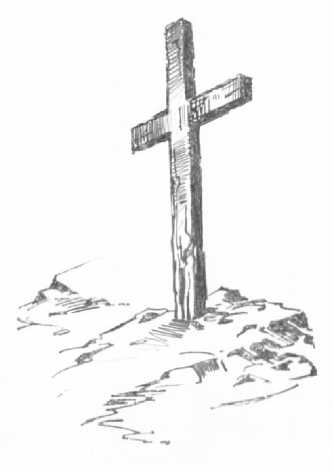
Список литературы The mystery of the Neumayers strait
- Брейтфус Л. Л. Северные полярные экспедиции 1912 г. и их поиски. Петроград, 1915.
- Osservaziom scientifiche, eseguite Durante la spedizione polare di S. A. R. Luigi Amedeo di Savoia. Милан, 1903.
- Дневник начальника полюсной экспедиции Г. Я. Седова.
- Дневник матроса шхуны «Св. Муч. Фока» А. Пустошного.
- Дневник матроса шхуны «Св. Муч. Фока» Г. Линника.
- Федоров Е. К. Полярные дневники. Гидрометеоиздат, 1979. C. 96.
- URL: http://litau.ru/expeditions/zfi-2011.
- ГААО. Протокол опроса секретаря Седовского комитета капитана 2-го ранга П. И. Белавенца от 5 декабря 1914 г.
- ГААО. Протокол опроса Г. Линника и А. Пустошного от 12 сентября 1914 г.
- Громов Б. Поход Седова. Экспедиция Седова на Землю Франца Иосифа в 1929 году. Молодая гвардия, 1930. С. 62.
- Пинегин Н. В ледяных просторах. Экспедиция Г. Я. Седова к Северному Полюсу. Издательство писателей в Ленинграде, 1933.
- Аккуратов В. Флаг на лыжной палке. Вокруг Света. 1964. № 4.

